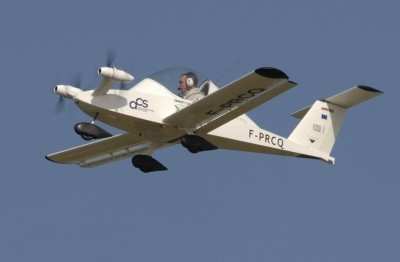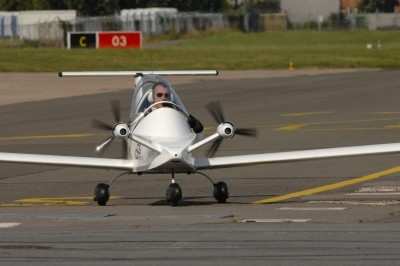Fri, Sep 03, 2010
Four Electric Motors, Lithium Batteries Power Tiny
Airplane
The all electric Cri-Cri, jointly developed by EADS Innovation
Works, Aero Composites Saintonge and the Green Cri-Cri Association,
made its official maiden flight at Le Bourget airport near Paris
Thursday. This Cri-Cri is the first-ever four-engined all-electric
aerobatic plane, which was first shown at the Green Aviation Show
at Le Bourget in June.

Cri-Cri In Flight
The plane became airborne at 1112 CET. Test pilot Didier Esteyne
said take-off and climb were smooth, no vibrations could be felt
and maneuverability was excellent. All systems performed well and
the plane returned safely after 7 minutes. “This aircraft
flies very smoothly, much more quietly than a plane with
conventional propulsion”, said Esteyne. “But we are
still at the beginning and have a lot to learn. We are allowed to
start aerobatic maneuvers only after five hours of flight and 15
landings.”
“The Cri-Cri is a low-cost test bed for system integration
of electrical technologies in support of projects like our hybrid
propulsion concept for helicopters,” stated Jean Botti,
EADS’s Chief Technical Officer. “We hope to get a lot
of useful information out of this project.” In the near
future batteries will be available to propel larger
aircraft.

The aerobatic plane incorporates numerous innovative
technologies such as lightweight composite structures that reduce
the weight of the airframe and compensate for the additional weight
of the batteries, four brushless electric motors with
counter-rotating propellers which deliver propulsion without CO2
emissions and significantly lower noise compared to thermal
propulsion, and high energy-density Lithium batteries. The combined
utilization of these environment-friendly technical innovations
enables the Cri-Cri to deliver 30 minutes of autonomous
cruise flight at about 60 knots, or 15 minutes of autonomous
aerobatics at speeds reaching up to 135 knots, and a climb rate of
approximately 1,000 fpm.
More News
Airport Marking Aids Markings used on runway and taxiway surfaces to identify a specific runway, a runway threshold, a centerline, a hold line, etc. A runway should be marked in ac>[...]
"It is extremely difficult, if not impossible, for manned aircraft to see a drone while conducting crop-enhancing and other aerial applications at low altitudes and high speeds. We>[...]
Aero Linx: The Skyhawk Association The Skyhawk Association is a non-profit organization founded by former Skyhawk Pilots which is open to anyone with an affinity for the A-4 Skyhaw>[...]
“The T-54A benefits from an active Beechcraft King Air assembly line in Wichita, Kansas, where all required METS avionics and interior modifications are installed on the line>[...]
Aero Linx: Aerostar Owners Association The Association offers the Aerostar Owner a unique opportunity to tap an invaluable source of information concerning the care and feeding of >[...]
 ANN's Daily Aero-Term (04.28.24): Airport Marking Aids
ANN's Daily Aero-Term (04.28.24): Airport Marking Aids Aero-News: Quote of the Day (04.28.24)
Aero-News: Quote of the Day (04.28.24) ANN's Daily Aero-Linx (04.28.24)
ANN's Daily Aero-Linx (04.28.24) Aero-News: Quote of the Day (04.29.24)
Aero-News: Quote of the Day (04.29.24) ANN's Daily Aero-Linx (04.29.24)
ANN's Daily Aero-Linx (04.29.24)




